Sales Management Report: Alpaca Coffee Analysis and Strategies
VerifiedAdded on 2022/09/21
|12
|3455
|22
Report
AI Summary
This report provides a comprehensive analysis of sales management strategies tailored for Alpaca Coffee, a brand emphasizing eco-friendly and sustainable practices. It begins with an executive summary outlining the company's mission to provide plastic-free coffee products and its focus on addressing the environmental impact of the coffee industry. The introduction establishes the brand's unique selling proposition and the importance of sustainable selling. The report then delves into key principles and techniques, including the importance of association, problem-solving, and value-based pricing. It explores SPIN selling and Challenger Sale techniques. The report also examines how these principles contribute to customer relationship management and contrasts Alpaca Coffee's approach with that of Starbucks. The report then discusses selling through others, highlighting the benefits of retail distribution. Finally, it explores relevant sales structures, specifically geographic and market-based approaches, to optimize sales force deployment and target specific customer segments.
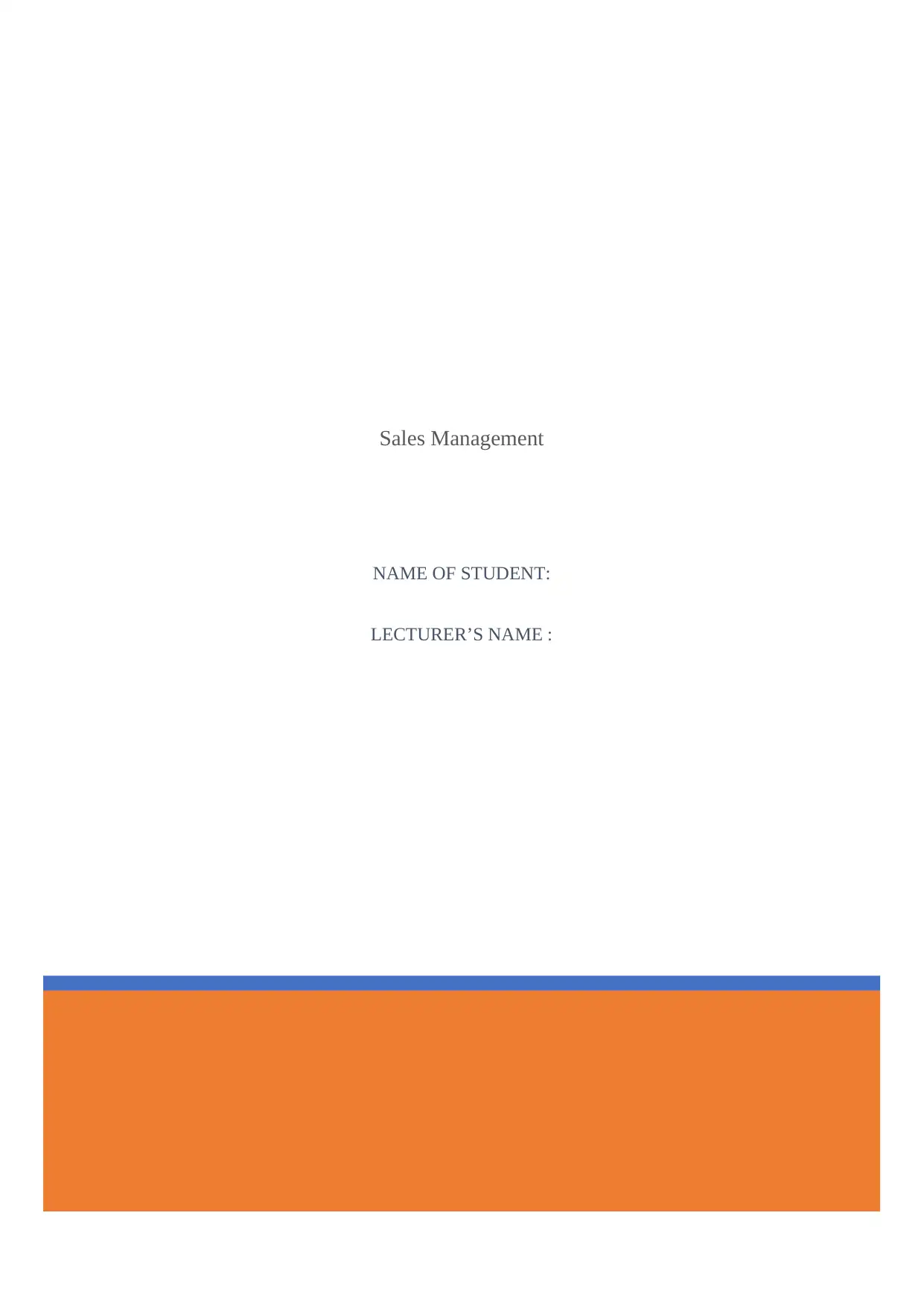
Sales Management
NAME OF STUDENT:
LECTURER’S NAME :
NAME OF STUDENT:
LECTURER’S NAME :
Paraphrase This Document
Need a fresh take? Get an instant paraphrase of this document with our AI Paraphraser
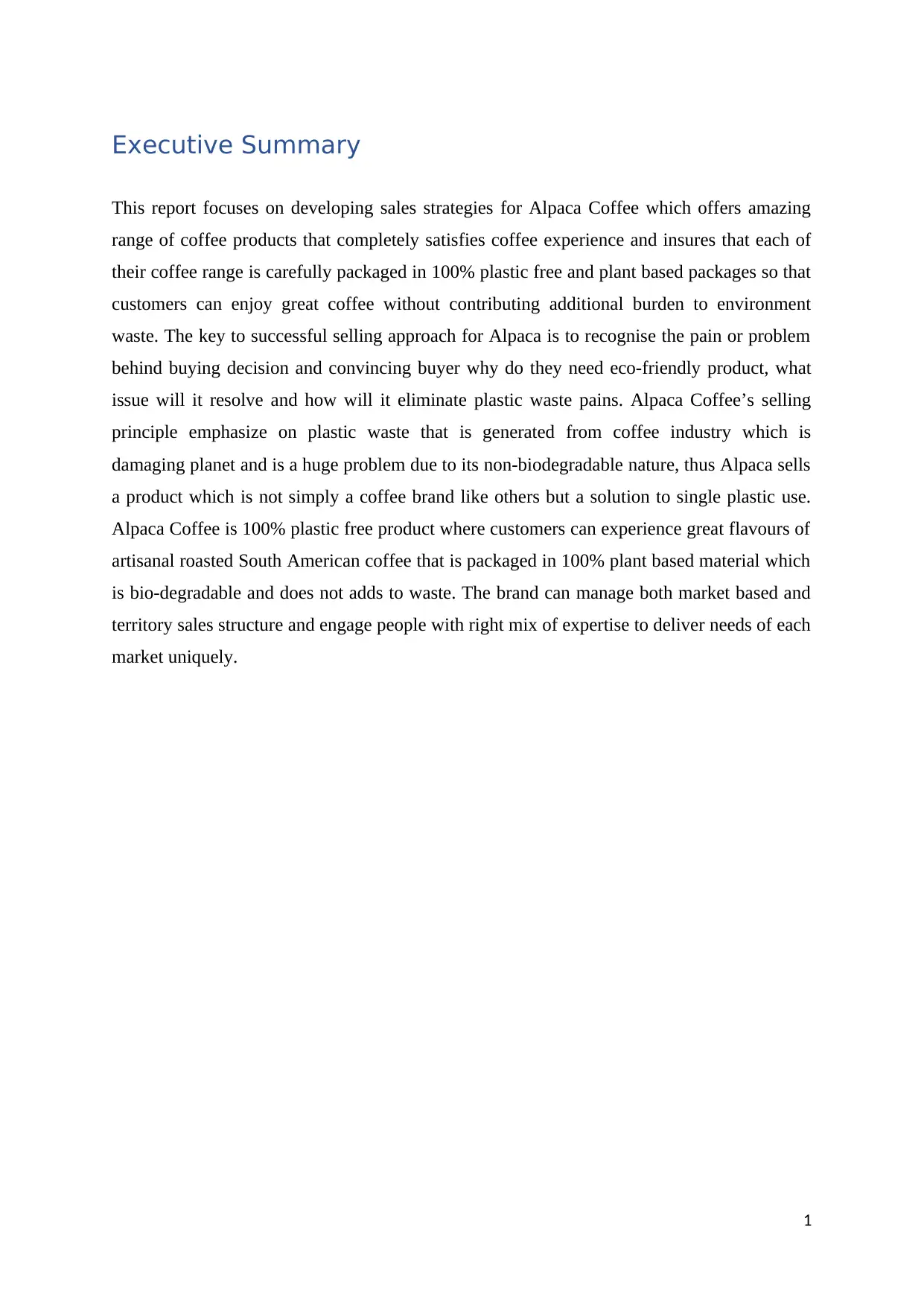
Executive Summary
This report focuses on developing sales strategies for Alpaca Coffee which offers amazing
range of coffee products that completely satisfies coffee experience and insures that each of
their coffee range is carefully packaged in 100% plastic free and plant based packages so that
customers can enjoy great coffee without contributing additional burden to environment
waste. The key to successful selling approach for Alpaca is to recognise the pain or problem
behind buying decision and convincing buyer why do they need eco-friendly product, what
issue will it resolve and how will it eliminate plastic waste pains. Alpaca Coffee’s selling
principle emphasize on plastic waste that is generated from coffee industry which is
damaging planet and is a huge problem due to its non-biodegradable nature, thus Alpaca sells
a product which is not simply a coffee brand like others but a solution to single plastic use.
Alpaca Coffee is 100% plastic free product where customers can experience great flavours of
artisanal roasted South American coffee that is packaged in 100% plant based material which
is bio-degradable and does not adds to waste. The brand can manage both market based and
territory sales structure and engage people with right mix of expertise to deliver needs of each
market uniquely.
1
This report focuses on developing sales strategies for Alpaca Coffee which offers amazing
range of coffee products that completely satisfies coffee experience and insures that each of
their coffee range is carefully packaged in 100% plastic free and plant based packages so that
customers can enjoy great coffee without contributing additional burden to environment
waste. The key to successful selling approach for Alpaca is to recognise the pain or problem
behind buying decision and convincing buyer why do they need eco-friendly product, what
issue will it resolve and how will it eliminate plastic waste pains. Alpaca Coffee’s selling
principle emphasize on plastic waste that is generated from coffee industry which is
damaging planet and is a huge problem due to its non-biodegradable nature, thus Alpaca sells
a product which is not simply a coffee brand like others but a solution to single plastic use.
Alpaca Coffee is 100% plastic free product where customers can experience great flavours of
artisanal roasted South American coffee that is packaged in 100% plant based material which
is bio-degradable and does not adds to waste. The brand can manage both market based and
territory sales structure and engage people with right mix of expertise to deliver needs of each
market uniquely.
1

Contents
Executive Summary...............................................................................................................................1
Introduction...........................................................................................................................................3
Principles and Techniques.....................................................................................................................3
Selling through Others...........................................................................................................................6
Sales Structures.....................................................................................................................................6
Conclusion.............................................................................................................................................8
References.............................................................................................................................................8
2
Executive Summary...............................................................................................................................1
Introduction...........................................................................................................................................3
Principles and Techniques.....................................................................................................................3
Selling through Others...........................................................................................................................6
Sales Structures.....................................................................................................................................6
Conclusion.............................................................................................................................................8
References.............................................................................................................................................8
2
⊘ This is a preview!⊘
Do you want full access?
Subscribe today to unlock all pages.

Trusted by 1+ million students worldwide
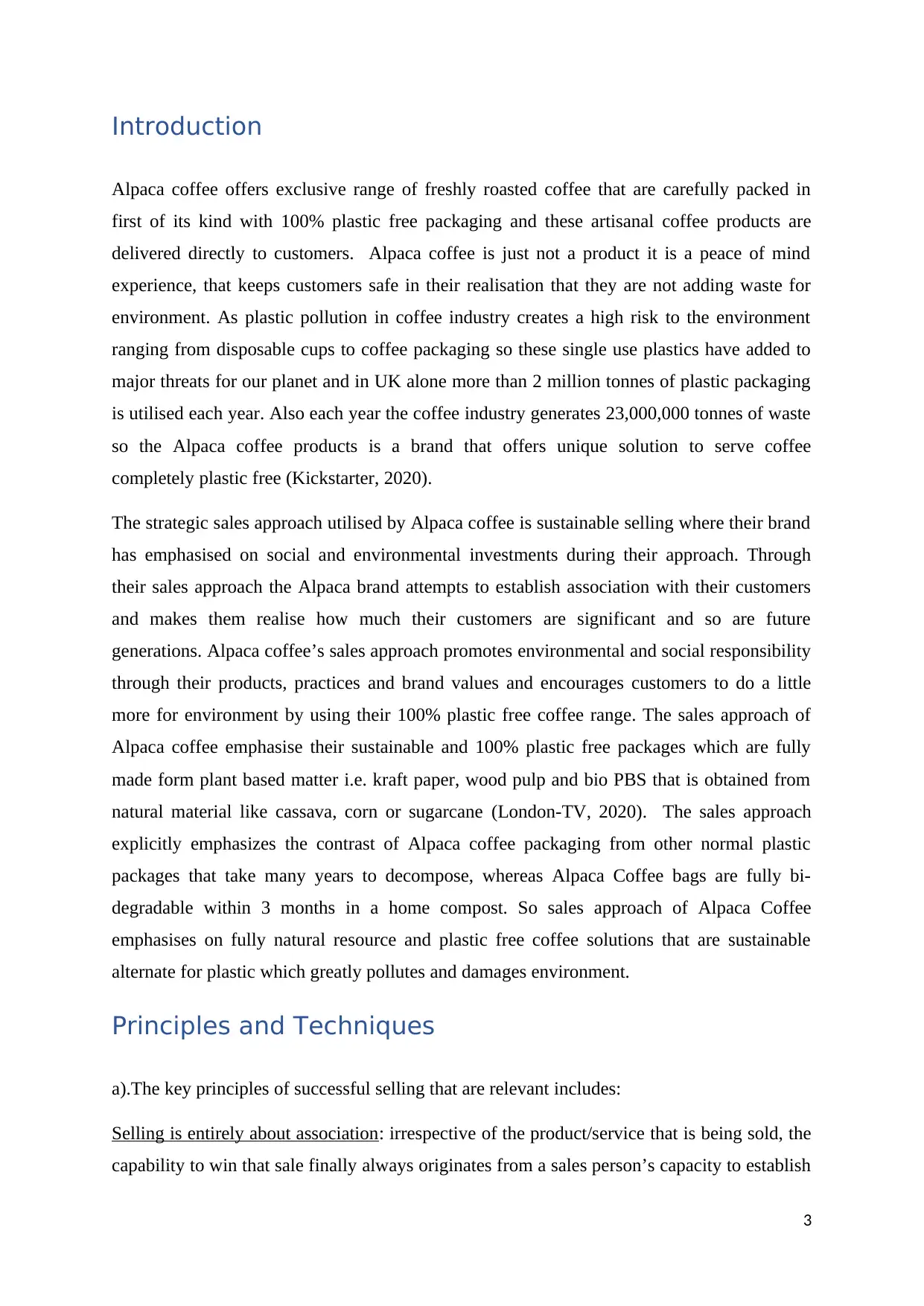
Introduction
Alpaca coffee offers exclusive range of freshly roasted coffee that are carefully packed in
first of its kind with 100% plastic free packaging and these artisanal coffee products are
delivered directly to customers. Alpaca coffee is just not a product it is a peace of mind
experience, that keeps customers safe in their realisation that they are not adding waste for
environment. As plastic pollution in coffee industry creates a high risk to the environment
ranging from disposable cups to coffee packaging so these single use plastics have added to
major threats for our planet and in UK alone more than 2 million tonnes of plastic packaging
is utilised each year. Also each year the coffee industry generates 23,000,000 tonnes of waste
so the Alpaca coffee products is a brand that offers unique solution to serve coffee
completely plastic free (Kickstarter, 2020).
The strategic sales approach utilised by Alpaca coffee is sustainable selling where their brand
has emphasised on social and environmental investments during their approach. Through
their sales approach the Alpaca brand attempts to establish association with their customers
and makes them realise how much their customers are significant and so are future
generations. Alpaca coffee’s sales approach promotes environmental and social responsibility
through their products, practices and brand values and encourages customers to do a little
more for environment by using their 100% plastic free coffee range. The sales approach of
Alpaca coffee emphasise their sustainable and 100% plastic free packages which are fully
made form plant based matter i.e. kraft paper, wood pulp and bio PBS that is obtained from
natural material like cassava, corn or sugarcane (London-TV, 2020). The sales approach
explicitly emphasizes the contrast of Alpaca coffee packaging from other normal plastic
packages that take many years to decompose, whereas Alpaca Coffee bags are fully bi-
degradable within 3 months in a home compost. So sales approach of Alpaca Coffee
emphasises on fully natural resource and plastic free coffee solutions that are sustainable
alternate for plastic which greatly pollutes and damages environment.
Principles and Techniques
a).The key principles of successful selling that are relevant includes:
Selling is entirely about association: irrespective of the product/service that is being sold, the
capability to win that sale finally always originates from a sales person’s capacity to establish
3
Alpaca coffee offers exclusive range of freshly roasted coffee that are carefully packed in
first of its kind with 100% plastic free packaging and these artisanal coffee products are
delivered directly to customers. Alpaca coffee is just not a product it is a peace of mind
experience, that keeps customers safe in their realisation that they are not adding waste for
environment. As plastic pollution in coffee industry creates a high risk to the environment
ranging from disposable cups to coffee packaging so these single use plastics have added to
major threats for our planet and in UK alone more than 2 million tonnes of plastic packaging
is utilised each year. Also each year the coffee industry generates 23,000,000 tonnes of waste
so the Alpaca coffee products is a brand that offers unique solution to serve coffee
completely plastic free (Kickstarter, 2020).
The strategic sales approach utilised by Alpaca coffee is sustainable selling where their brand
has emphasised on social and environmental investments during their approach. Through
their sales approach the Alpaca brand attempts to establish association with their customers
and makes them realise how much their customers are significant and so are future
generations. Alpaca coffee’s sales approach promotes environmental and social responsibility
through their products, practices and brand values and encourages customers to do a little
more for environment by using their 100% plastic free coffee range. The sales approach of
Alpaca coffee emphasise their sustainable and 100% plastic free packages which are fully
made form plant based matter i.e. kraft paper, wood pulp and bio PBS that is obtained from
natural material like cassava, corn or sugarcane (London-TV, 2020). The sales approach
explicitly emphasizes the contrast of Alpaca coffee packaging from other normal plastic
packages that take many years to decompose, whereas Alpaca Coffee bags are fully bi-
degradable within 3 months in a home compost. So sales approach of Alpaca Coffee
emphasises on fully natural resource and plastic free coffee solutions that are sustainable
alternate for plastic which greatly pollutes and damages environment.
Principles and Techniques
a).The key principles of successful selling that are relevant includes:
Selling is entirely about association: irrespective of the product/service that is being sold, the
capability to win that sale finally always originates from a sales person’s capacity to establish
3
Paraphrase This Document
Need a fresh take? Get an instant paraphrase of this document with our AI Paraphraser
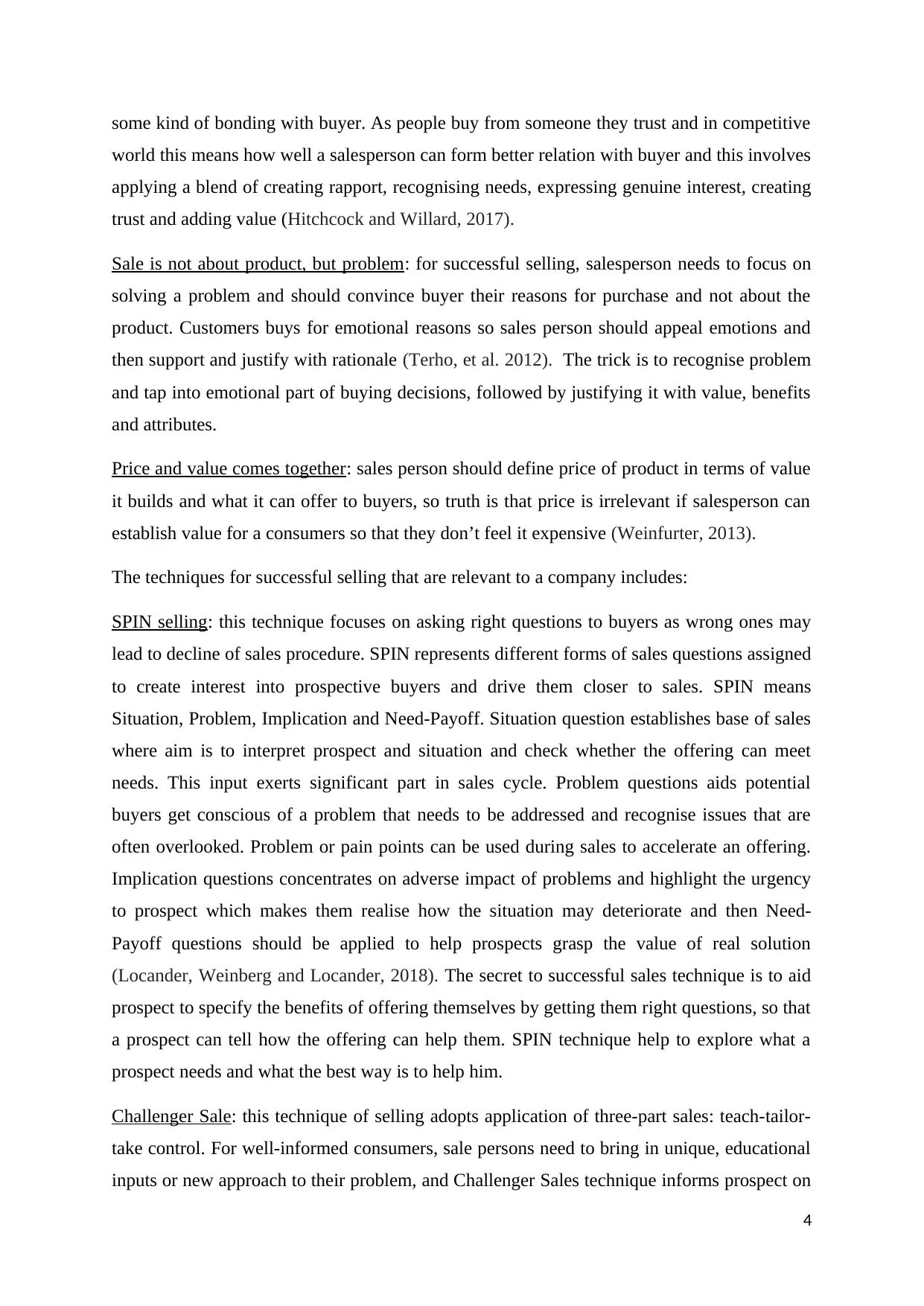
some kind of bonding with buyer. As people buy from someone they trust and in competitive
world this means how well a salesperson can form better relation with buyer and this involves
applying a blend of creating rapport, recognising needs, expressing genuine interest, creating
trust and adding value (Hitchcock and Willard, 2017).
Sale is not about product, but problem: for successful selling, salesperson needs to focus on
solving a problem and should convince buyer their reasons for purchase and not about the
product. Customers buys for emotional reasons so sales person should appeal emotions and
then support and justify with rationale (Terho, et al. 2012). The trick is to recognise problem
and tap into emotional part of buying decisions, followed by justifying it with value, benefits
and attributes.
Price and value comes together: sales person should define price of product in terms of value
it builds and what it can offer to buyers, so truth is that price is irrelevant if salesperson can
establish value for a consumers so that they don’t feel it expensive (Weinfurter, 2013).
The techniques for successful selling that are relevant to a company includes:
SPIN selling: this technique focuses on asking right questions to buyers as wrong ones may
lead to decline of sales procedure. SPIN represents different forms of sales questions assigned
to create interest into prospective buyers and drive them closer to sales. SPIN means
Situation, Problem, Implication and Need-Payoff. Situation question establishes base of sales
where aim is to interpret prospect and situation and check whether the offering can meet
needs. This input exerts significant part in sales cycle. Problem questions aids potential
buyers get conscious of a problem that needs to be addressed and recognise issues that are
often overlooked. Problem or pain points can be used during sales to accelerate an offering.
Implication questions concentrates on adverse impact of problems and highlight the urgency
to prospect which makes them realise how the situation may deteriorate and then Need-
Payoff questions should be applied to help prospects grasp the value of real solution
(Locander, Weinberg and Locander, 2018). The secret to successful sales technique is to aid
prospect to specify the benefits of offering themselves by getting them right questions, so that
a prospect can tell how the offering can help them. SPIN technique help to explore what a
prospect needs and what the best way is to help him.
Challenger Sale: this technique of selling adopts application of three-part sales: teach-tailor-
take control. For well-informed consumers, sale persons need to bring in unique, educational
inputs or new approach to their problem, and Challenger Sales technique informs prospect on
4
world this means how well a salesperson can form better relation with buyer and this involves
applying a blend of creating rapport, recognising needs, expressing genuine interest, creating
trust and adding value (Hitchcock and Willard, 2017).
Sale is not about product, but problem: for successful selling, salesperson needs to focus on
solving a problem and should convince buyer their reasons for purchase and not about the
product. Customers buys for emotional reasons so sales person should appeal emotions and
then support and justify with rationale (Terho, et al. 2012). The trick is to recognise problem
and tap into emotional part of buying decisions, followed by justifying it with value, benefits
and attributes.
Price and value comes together: sales person should define price of product in terms of value
it builds and what it can offer to buyers, so truth is that price is irrelevant if salesperson can
establish value for a consumers so that they don’t feel it expensive (Weinfurter, 2013).
The techniques for successful selling that are relevant to a company includes:
SPIN selling: this technique focuses on asking right questions to buyers as wrong ones may
lead to decline of sales procedure. SPIN represents different forms of sales questions assigned
to create interest into prospective buyers and drive them closer to sales. SPIN means
Situation, Problem, Implication and Need-Payoff. Situation question establishes base of sales
where aim is to interpret prospect and situation and check whether the offering can meet
needs. This input exerts significant part in sales cycle. Problem questions aids potential
buyers get conscious of a problem that needs to be addressed and recognise issues that are
often overlooked. Problem or pain points can be used during sales to accelerate an offering.
Implication questions concentrates on adverse impact of problems and highlight the urgency
to prospect which makes them realise how the situation may deteriorate and then Need-
Payoff questions should be applied to help prospects grasp the value of real solution
(Locander, Weinberg and Locander, 2018). The secret to successful sales technique is to aid
prospect to specify the benefits of offering themselves by getting them right questions, so that
a prospect can tell how the offering can help them. SPIN technique help to explore what a
prospect needs and what the best way is to help him.
Challenger Sale: this technique of selling adopts application of three-part sales: teach-tailor-
take control. For well-informed consumers, sale persons need to bring in unique, educational
inputs or new approach to their problem, and Challenger Sales technique informs prospect on
4
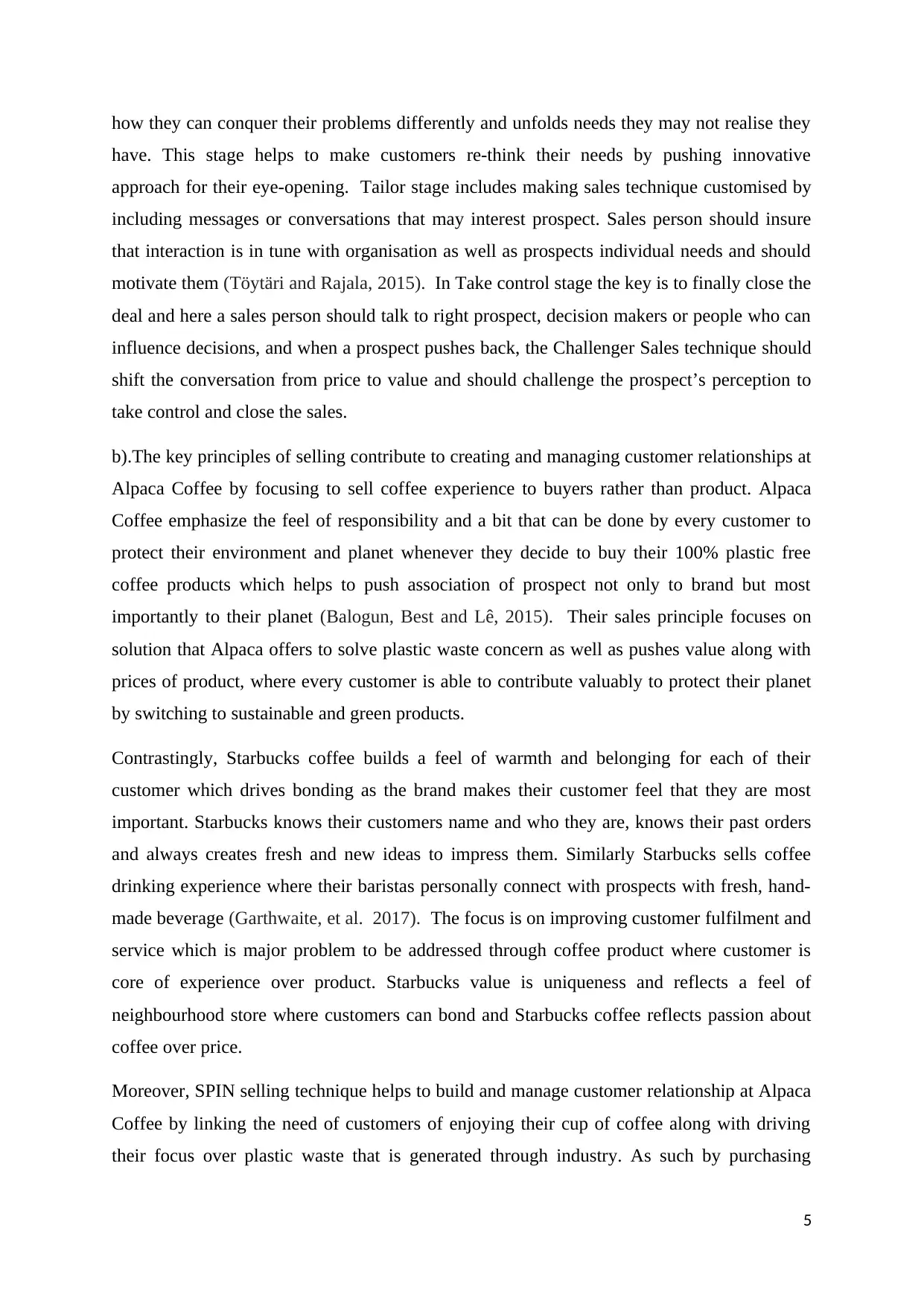
how they can conquer their problems differently and unfolds needs they may not realise they
have. This stage helps to make customers re-think their needs by pushing innovative
approach for their eye-opening. Tailor stage includes making sales technique customised by
including messages or conversations that may interest prospect. Sales person should insure
that interaction is in tune with organisation as well as prospects individual needs and should
motivate them (Töytäri and Rajala, 2015). In Take control stage the key is to finally close the
deal and here a sales person should talk to right prospect, decision makers or people who can
influence decisions, and when a prospect pushes back, the Challenger Sales technique should
shift the conversation from price to value and should challenge the prospect’s perception to
take control and close the sales.
b).The key principles of selling contribute to creating and managing customer relationships at
Alpaca Coffee by focusing to sell coffee experience to buyers rather than product. Alpaca
Coffee emphasize the feel of responsibility and a bit that can be done by every customer to
protect their environment and planet whenever they decide to buy their 100% plastic free
coffee products which helps to push association of prospect not only to brand but most
importantly to their planet (Balogun, Best and Lê, 2015). Their sales principle focuses on
solution that Alpaca offers to solve plastic waste concern as well as pushes value along with
prices of product, where every customer is able to contribute valuably to protect their planet
by switching to sustainable and green products.
Contrastingly, Starbucks coffee builds a feel of warmth and belonging for each of their
customer which drives bonding as the brand makes their customer feel that they are most
important. Starbucks knows their customers name and who they are, knows their past orders
and always creates fresh and new ideas to impress them. Similarly Starbucks sells coffee
drinking experience where their baristas personally connect with prospects with fresh, hand-
made beverage (Garthwaite, et al. 2017). The focus is on improving customer fulfilment and
service which is major problem to be addressed through coffee product where customer is
core of experience over product. Starbucks value is uniqueness and reflects a feel of
neighbourhood store where customers can bond and Starbucks coffee reflects passion about
coffee over price.
Moreover, SPIN selling technique helps to build and manage customer relationship at Alpaca
Coffee by linking the need of customers of enjoying their cup of coffee along with driving
their focus over plastic waste that is generated through industry. As such by purchasing
5
have. This stage helps to make customers re-think their needs by pushing innovative
approach for their eye-opening. Tailor stage includes making sales technique customised by
including messages or conversations that may interest prospect. Sales person should insure
that interaction is in tune with organisation as well as prospects individual needs and should
motivate them (Töytäri and Rajala, 2015). In Take control stage the key is to finally close the
deal and here a sales person should talk to right prospect, decision makers or people who can
influence decisions, and when a prospect pushes back, the Challenger Sales technique should
shift the conversation from price to value and should challenge the prospect’s perception to
take control and close the sales.
b).The key principles of selling contribute to creating and managing customer relationships at
Alpaca Coffee by focusing to sell coffee experience to buyers rather than product. Alpaca
Coffee emphasize the feel of responsibility and a bit that can be done by every customer to
protect their environment and planet whenever they decide to buy their 100% plastic free
coffee products which helps to push association of prospect not only to brand but most
importantly to their planet (Balogun, Best and Lê, 2015). Their sales principle focuses on
solution that Alpaca offers to solve plastic waste concern as well as pushes value along with
prices of product, where every customer is able to contribute valuably to protect their planet
by switching to sustainable and green products.
Contrastingly, Starbucks coffee builds a feel of warmth and belonging for each of their
customer which drives bonding as the brand makes their customer feel that they are most
important. Starbucks knows their customers name and who they are, knows their past orders
and always creates fresh and new ideas to impress them. Similarly Starbucks sells coffee
drinking experience where their baristas personally connect with prospects with fresh, hand-
made beverage (Garthwaite, et al. 2017). The focus is on improving customer fulfilment and
service which is major problem to be addressed through coffee product where customer is
core of experience over product. Starbucks value is uniqueness and reflects a feel of
neighbourhood store where customers can bond and Starbucks coffee reflects passion about
coffee over price.
Moreover, SPIN selling technique helps to build and manage customer relationship at Alpaca
Coffee by linking the need of customers of enjoying their cup of coffee along with driving
their focus over plastic waste that is generated through industry. As such by purchasing
5
⊘ This is a preview!⊘
Do you want full access?
Subscribe today to unlock all pages.

Trusted by 1+ million students worldwide
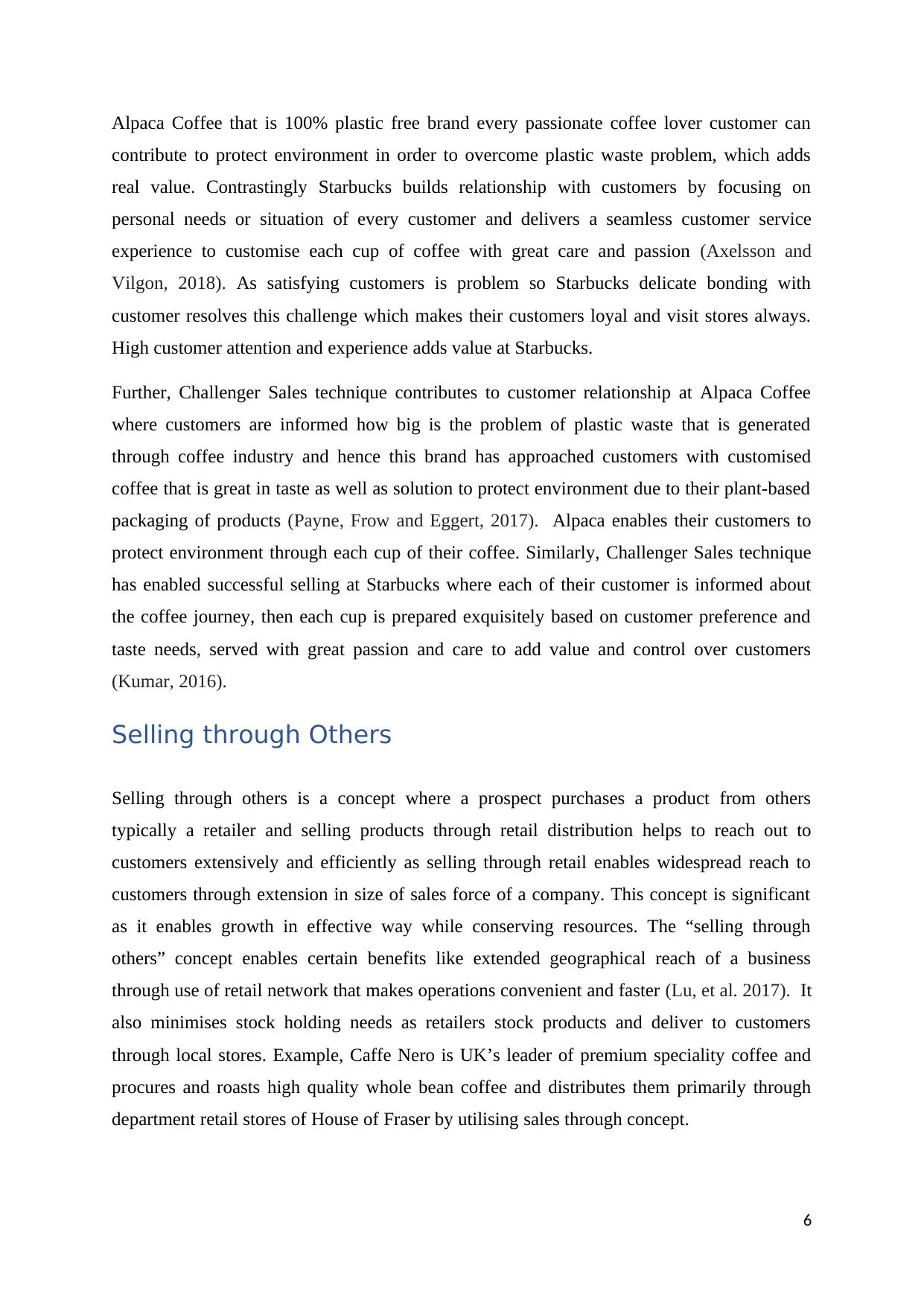
Alpaca Coffee that is 100% plastic free brand every passionate coffee lover customer can
contribute to protect environment in order to overcome plastic waste problem, which adds
real value. Contrastingly Starbucks builds relationship with customers by focusing on
personal needs or situation of every customer and delivers a seamless customer service
experience to customise each cup of coffee with great care and passion (Axelsson and
Vilgon, 2018). As satisfying customers is problem so Starbucks delicate bonding with
customer resolves this challenge which makes their customers loyal and visit stores always.
High customer attention and experience adds value at Starbucks.
Further, Challenger Sales technique contributes to customer relationship at Alpaca Coffee
where customers are informed how big is the problem of plastic waste that is generated
through coffee industry and hence this brand has approached customers with customised
coffee that is great in taste as well as solution to protect environment due to their plant-based
packaging of products (Payne, Frow and Eggert, 2017). Alpaca enables their customers to
protect environment through each cup of their coffee. Similarly, Challenger Sales technique
has enabled successful selling at Starbucks where each of their customer is informed about
the coffee journey, then each cup is prepared exquisitely based on customer preference and
taste needs, served with great passion and care to add value and control over customers
(Kumar, 2016).
Selling through Others
Selling through others is a concept where a prospect purchases a product from others
typically a retailer and selling products through retail distribution helps to reach out to
customers extensively and efficiently as selling through retail enables widespread reach to
customers through extension in size of sales force of a company. This concept is significant
as it enables growth in effective way while conserving resources. The “selling through
others” concept enables certain benefits like extended geographical reach of a business
through use of retail network that makes operations convenient and faster (Lu, et al. 2017). It
also minimises stock holding needs as retailers stock products and deliver to customers
through local stores. Example, Caffe Nero is UK’s leader of premium speciality coffee and
procures and roasts high quality whole bean coffee and distributes them primarily through
department retail stores of House of Fraser by utilising sales through concept.
6
contribute to protect environment in order to overcome plastic waste problem, which adds
real value. Contrastingly Starbucks builds relationship with customers by focusing on
personal needs or situation of every customer and delivers a seamless customer service
experience to customise each cup of coffee with great care and passion (Axelsson and
Vilgon, 2018). As satisfying customers is problem so Starbucks delicate bonding with
customer resolves this challenge which makes their customers loyal and visit stores always.
High customer attention and experience adds value at Starbucks.
Further, Challenger Sales technique contributes to customer relationship at Alpaca Coffee
where customers are informed how big is the problem of plastic waste that is generated
through coffee industry and hence this brand has approached customers with customised
coffee that is great in taste as well as solution to protect environment due to their plant-based
packaging of products (Payne, Frow and Eggert, 2017). Alpaca enables their customers to
protect environment through each cup of their coffee. Similarly, Challenger Sales technique
has enabled successful selling at Starbucks where each of their customer is informed about
the coffee journey, then each cup is prepared exquisitely based on customer preference and
taste needs, served with great passion and care to add value and control over customers
(Kumar, 2016).
Selling through Others
Selling through others is a concept where a prospect purchases a product from others
typically a retailer and selling products through retail distribution helps to reach out to
customers extensively and efficiently as selling through retail enables widespread reach to
customers through extension in size of sales force of a company. This concept is significant
as it enables growth in effective way while conserving resources. The “selling through
others” concept enables certain benefits like extended geographical reach of a business
through use of retail network that makes operations convenient and faster (Lu, et al. 2017). It
also minimises stock holding needs as retailers stock products and deliver to customers
through local stores. Example, Caffe Nero is UK’s leader of premium speciality coffee and
procures and roasts high quality whole bean coffee and distributes them primarily through
department retail stores of House of Fraser by utilising sales through concept.
6
Paraphrase This Document
Need a fresh take? Get an instant paraphrase of this document with our AI Paraphraser
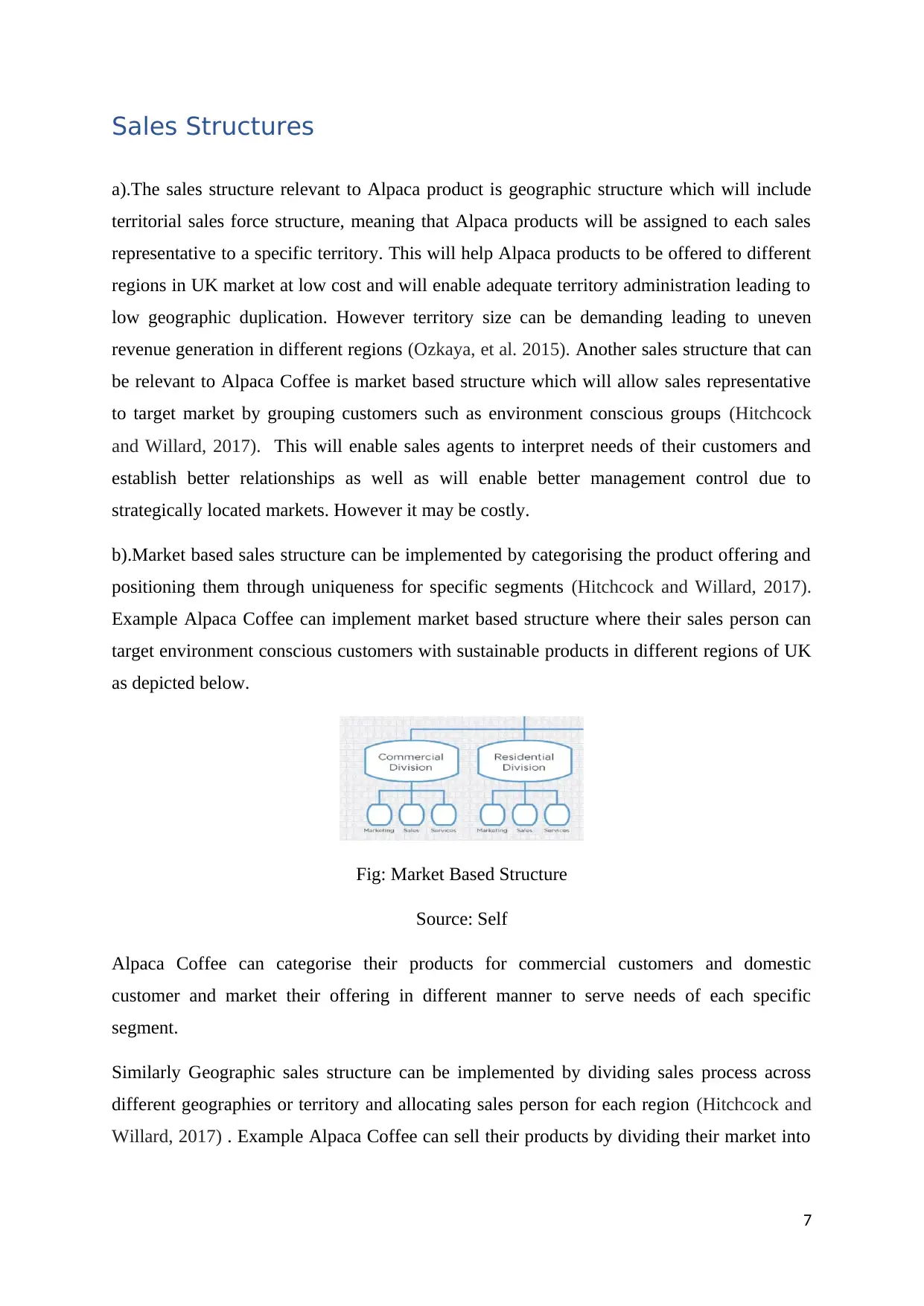
Sales Structures
a).The sales structure relevant to Alpaca product is geographic structure which will include
territorial sales force structure, meaning that Alpaca products will be assigned to each sales
representative to a specific territory. This will help Alpaca products to be offered to different
regions in UK market at low cost and will enable adequate territory administration leading to
low geographic duplication. However territory size can be demanding leading to uneven
revenue generation in different regions (Ozkaya, et al. 2015). Another sales structure that can
be relevant to Alpaca Coffee is market based structure which will allow sales representative
to target market by grouping customers such as environment conscious groups (Hitchcock
and Willard, 2017). This will enable sales agents to interpret needs of their customers and
establish better relationships as well as will enable better management control due to
strategically located markets. However it may be costly.
b).Market based sales structure can be implemented by categorising the product offering and
positioning them through uniqueness for specific segments (Hitchcock and Willard, 2017).
Example Alpaca Coffee can implement market based structure where their sales person can
target environment conscious customers with sustainable products in different regions of UK
as depicted below.
Fig: Market Based Structure
Source: Self
Alpaca Coffee can categorise their products for commercial customers and domestic
customer and market their offering in different manner to serve needs of each specific
segment.
Similarly Geographic sales structure can be implemented by dividing sales process across
different geographies or territory and allocating sales person for each region (Hitchcock and
Willard, 2017) . Example Alpaca Coffee can sell their products by dividing their market into
7
a).The sales structure relevant to Alpaca product is geographic structure which will include
territorial sales force structure, meaning that Alpaca products will be assigned to each sales
representative to a specific territory. This will help Alpaca products to be offered to different
regions in UK market at low cost and will enable adequate territory administration leading to
low geographic duplication. However territory size can be demanding leading to uneven
revenue generation in different regions (Ozkaya, et al. 2015). Another sales structure that can
be relevant to Alpaca Coffee is market based structure which will allow sales representative
to target market by grouping customers such as environment conscious groups (Hitchcock
and Willard, 2017). This will enable sales agents to interpret needs of their customers and
establish better relationships as well as will enable better management control due to
strategically located markets. However it may be costly.
b).Market based sales structure can be implemented by categorising the product offering and
positioning them through uniqueness for specific segments (Hitchcock and Willard, 2017).
Example Alpaca Coffee can implement market based structure where their sales person can
target environment conscious customers with sustainable products in different regions of UK
as depicted below.
Fig: Market Based Structure
Source: Self
Alpaca Coffee can categorise their products for commercial customers and domestic
customer and market their offering in different manner to serve needs of each specific
segment.
Similarly Geographic sales structure can be implemented by dividing sales process across
different geographies or territory and allocating sales person for each region (Hitchcock and
Willard, 2017) . Example Alpaca Coffee can sell their products by dividing their market into
7
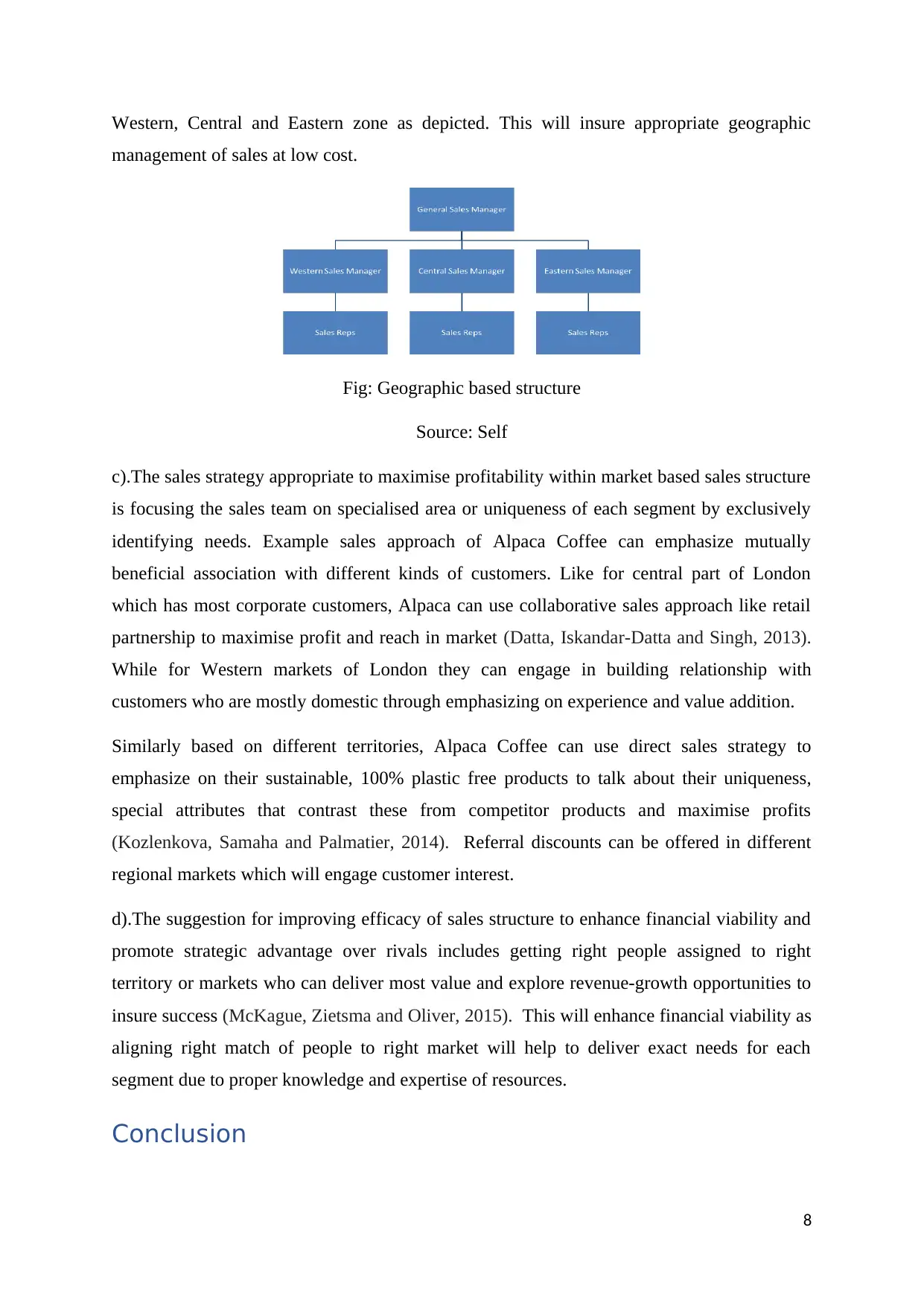
Western, Central and Eastern zone as depicted. This will insure appropriate geographic
management of sales at low cost.
Fig: Geographic based structure
Source: Self
c).The sales strategy appropriate to maximise profitability within market based sales structure
is focusing the sales team on specialised area or uniqueness of each segment by exclusively
identifying needs. Example sales approach of Alpaca Coffee can emphasize mutually
beneficial association with different kinds of customers. Like for central part of London
which has most corporate customers, Alpaca can use collaborative sales approach like retail
partnership to maximise profit and reach in market (Datta, Iskandar-Datta and Singh, 2013).
While for Western markets of London they can engage in building relationship with
customers who are mostly domestic through emphasizing on experience and value addition.
Similarly based on different territories, Alpaca Coffee can use direct sales strategy to
emphasize on their sustainable, 100% plastic free products to talk about their uniqueness,
special attributes that contrast these from competitor products and maximise profits
(Kozlenkova, Samaha and Palmatier, 2014). Referral discounts can be offered in different
regional markets which will engage customer interest.
d).The suggestion for improving efficacy of sales structure to enhance financial viability and
promote strategic advantage over rivals includes getting right people assigned to right
territory or markets who can deliver most value and explore revenue-growth opportunities to
insure success (McKague, Zietsma and Oliver, 2015). This will enhance financial viability as
aligning right match of people to right market will help to deliver exact needs for each
segment due to proper knowledge and expertise of resources.
Conclusion
8
management of sales at low cost.
Fig: Geographic based structure
Source: Self
c).The sales strategy appropriate to maximise profitability within market based sales structure
is focusing the sales team on specialised area or uniqueness of each segment by exclusively
identifying needs. Example sales approach of Alpaca Coffee can emphasize mutually
beneficial association with different kinds of customers. Like for central part of London
which has most corporate customers, Alpaca can use collaborative sales approach like retail
partnership to maximise profit and reach in market (Datta, Iskandar-Datta and Singh, 2013).
While for Western markets of London they can engage in building relationship with
customers who are mostly domestic through emphasizing on experience and value addition.
Similarly based on different territories, Alpaca Coffee can use direct sales strategy to
emphasize on their sustainable, 100% plastic free products to talk about their uniqueness,
special attributes that contrast these from competitor products and maximise profits
(Kozlenkova, Samaha and Palmatier, 2014). Referral discounts can be offered in different
regional markets which will engage customer interest.
d).The suggestion for improving efficacy of sales structure to enhance financial viability and
promote strategic advantage over rivals includes getting right people assigned to right
territory or markets who can deliver most value and explore revenue-growth opportunities to
insure success (McKague, Zietsma and Oliver, 2015). This will enhance financial viability as
aligning right match of people to right market will help to deliver exact needs for each
segment due to proper knowledge and expertise of resources.
Conclusion
8
⊘ This is a preview!⊘
Do you want full access?
Subscribe today to unlock all pages.

Trusted by 1+ million students worldwide
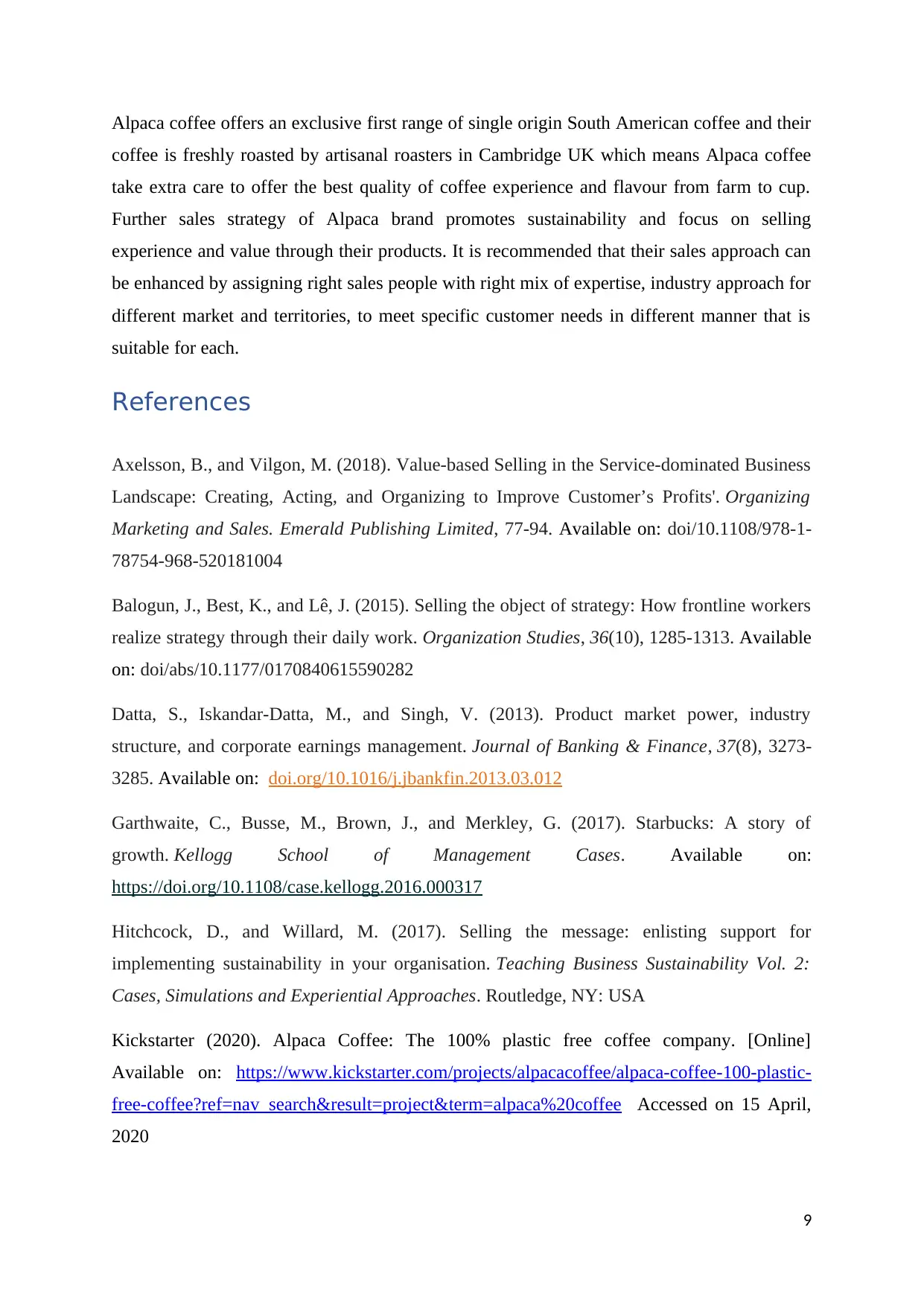
Alpaca coffee offers an exclusive first range of single origin South American coffee and their
coffee is freshly roasted by artisanal roasters in Cambridge UK which means Alpaca coffee
take extra care to offer the best quality of coffee experience and flavour from farm to cup.
Further sales strategy of Alpaca brand promotes sustainability and focus on selling
experience and value through their products. It is recommended that their sales approach can
be enhanced by assigning right sales people with right mix of expertise, industry approach for
different market and territories, to meet specific customer needs in different manner that is
suitable for each.
References
Axelsson, B., and Vilgon, M. (2018). Value-based Selling in the Service-dominated Business
Landscape: Creating, Acting, and Organizing to Improve Customer’s Profits'. Organizing
Marketing and Sales. Emerald Publishing Limited, 77-94. Available on: doi/10.1108/978-1-
78754-968-520181004
Balogun, J., Best, K., and Lê, J. (2015). Selling the object of strategy: How frontline workers
realize strategy through their daily work. Organization Studies, 36(10), 1285-1313. Available
on: doi/abs/10.1177/0170840615590282
Datta, S., Iskandar-Datta, M., and Singh, V. (2013). Product market power, industry
structure, and corporate earnings management. Journal of Banking & Finance, 37(8), 3273-
3285. Available on: doi.org/10.1016/j.jbankfin.2013.03.012
Garthwaite, C., Busse, M., Brown, J., and Merkley, G. (2017). Starbucks: A story of
growth. Kellogg School of Management Cases. Available on:
https://doi.org/10.1108/case.kellogg.2016.000317
Hitchcock, D., and Willard, M. (2017). Selling the message: enlisting support for
implementing sustainability in your organisation. Teaching Business Sustainability Vol. 2:
Cases, Simulations and Experiential Approaches. Routledge, NY: USA
Kickstarter (2020). Alpaca Coffee: The 100% plastic free coffee company. [Online]
Available on: https://www.kickstarter.com/projects/alpacacoffee/alpaca-coffee-100-plastic-
free-coffee?ref=nav_search&result=project&term=alpaca%20coffee Accessed on 15 April,
2020
9
coffee is freshly roasted by artisanal roasters in Cambridge UK which means Alpaca coffee
take extra care to offer the best quality of coffee experience and flavour from farm to cup.
Further sales strategy of Alpaca brand promotes sustainability and focus on selling
experience and value through their products. It is recommended that their sales approach can
be enhanced by assigning right sales people with right mix of expertise, industry approach for
different market and territories, to meet specific customer needs in different manner that is
suitable for each.
References
Axelsson, B., and Vilgon, M. (2018). Value-based Selling in the Service-dominated Business
Landscape: Creating, Acting, and Organizing to Improve Customer’s Profits'. Organizing
Marketing and Sales. Emerald Publishing Limited, 77-94. Available on: doi/10.1108/978-1-
78754-968-520181004
Balogun, J., Best, K., and Lê, J. (2015). Selling the object of strategy: How frontline workers
realize strategy through their daily work. Organization Studies, 36(10), 1285-1313. Available
on: doi/abs/10.1177/0170840615590282
Datta, S., Iskandar-Datta, M., and Singh, V. (2013). Product market power, industry
structure, and corporate earnings management. Journal of Banking & Finance, 37(8), 3273-
3285. Available on: doi.org/10.1016/j.jbankfin.2013.03.012
Garthwaite, C., Busse, M., Brown, J., and Merkley, G. (2017). Starbucks: A story of
growth. Kellogg School of Management Cases. Available on:
https://doi.org/10.1108/case.kellogg.2016.000317
Hitchcock, D., and Willard, M. (2017). Selling the message: enlisting support for
implementing sustainability in your organisation. Teaching Business Sustainability Vol. 2:
Cases, Simulations and Experiential Approaches. Routledge, NY: USA
Kickstarter (2020). Alpaca Coffee: The 100% plastic free coffee company. [Online]
Available on: https://www.kickstarter.com/projects/alpacacoffee/alpaca-coffee-100-plastic-
free-coffee?ref=nav_search&result=project&term=alpaca%20coffee Accessed on 15 April,
2020
9
Paraphrase This Document
Need a fresh take? Get an instant paraphrase of this document with our AI Paraphraser
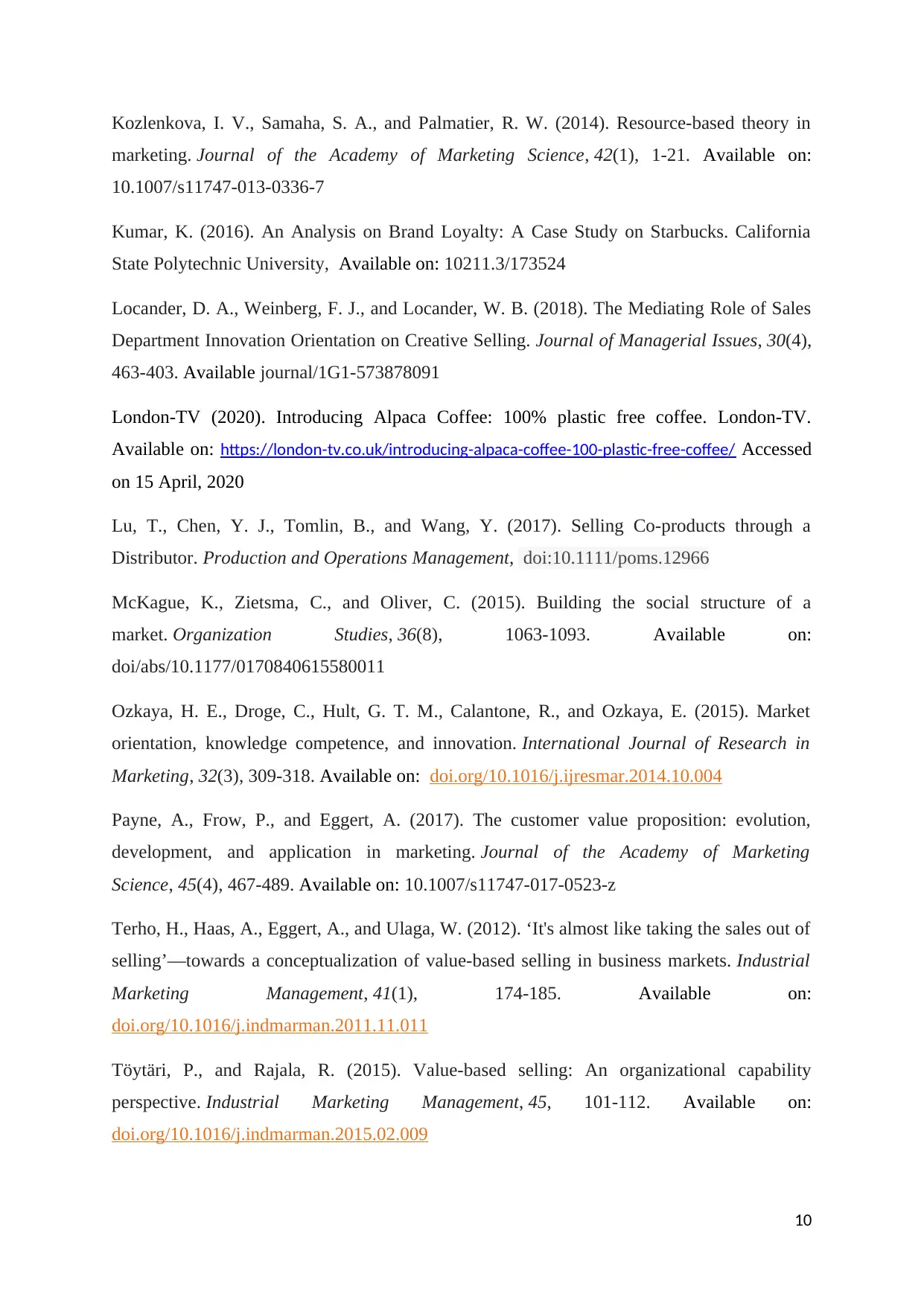
Kozlenkova, I. V., Samaha, S. A., and Palmatier, R. W. (2014). Resource-based theory in
marketing. Journal of the Academy of Marketing Science, 42(1), 1-21. Available on:
10.1007/s11747-013-0336-7
Kumar, K. (2016). An Analysis on Brand Loyalty: A Case Study on Starbucks. California
State Polytechnic University, Available on: 10211.3/173524
Locander, D. A., Weinberg, F. J., and Locander, W. B. (2018). The Mediating Role of Sales
Department Innovation Orientation on Creative Selling. Journal of Managerial Issues, 30(4),
463-403. Available journal/1G1-573878091
London-TV (2020). Introducing Alpaca Coffee: 100% plastic free coffee. London-TV.
Available on: https://london-tv.co.uk/introducing-alpaca-coffee-100-plastic-free-coffee/ Accessed
on 15 April, 2020
Lu, T., Chen, Y. J., Tomlin, B., and Wang, Y. (2017). Selling Co-products through a
Distributor. Production and Operations Management, doi:10.1111/poms.12966
McKague, K., Zietsma, C., and Oliver, C. (2015). Building the social structure of a
market. Organization Studies, 36(8), 1063-1093. Available on:
doi/abs/10.1177/0170840615580011
Ozkaya, H. E., Droge, C., Hult, G. T. M., Calantone, R., and Ozkaya, E. (2015). Market
orientation, knowledge competence, and innovation. International Journal of Research in
Marketing, 32(3), 309-318. Available on: doi.org/10.1016/j.ijresmar.2014.10.004
Payne, A., Frow, P., and Eggert, A. (2017). The customer value proposition: evolution,
development, and application in marketing. Journal of the Academy of Marketing
Science, 45(4), 467-489. Available on: 10.1007/s11747-017-0523-z
Terho, H., Haas, A., Eggert, A., and Ulaga, W. (2012). ‘It's almost like taking the sales out of
selling’—towards a conceptualization of value-based selling in business markets. Industrial
Marketing Management, 41(1), 174-185. Available on:
doi.org/10.1016/j.indmarman.2011.11.011
Töytäri, P., and Rajala, R. (2015). Value-based selling: An organizational capability
perspective. Industrial Marketing Management, 45, 101-112. Available on:
doi.org/10.1016/j.indmarman.2015.02.009
10
marketing. Journal of the Academy of Marketing Science, 42(1), 1-21. Available on:
10.1007/s11747-013-0336-7
Kumar, K. (2016). An Analysis on Brand Loyalty: A Case Study on Starbucks. California
State Polytechnic University, Available on: 10211.3/173524
Locander, D. A., Weinberg, F. J., and Locander, W. B. (2018). The Mediating Role of Sales
Department Innovation Orientation on Creative Selling. Journal of Managerial Issues, 30(4),
463-403. Available journal/1G1-573878091
London-TV (2020). Introducing Alpaca Coffee: 100% plastic free coffee. London-TV.
Available on: https://london-tv.co.uk/introducing-alpaca-coffee-100-plastic-free-coffee/ Accessed
on 15 April, 2020
Lu, T., Chen, Y. J., Tomlin, B., and Wang, Y. (2017). Selling Co-products through a
Distributor. Production and Operations Management, doi:10.1111/poms.12966
McKague, K., Zietsma, C., and Oliver, C. (2015). Building the social structure of a
market. Organization Studies, 36(8), 1063-1093. Available on:
doi/abs/10.1177/0170840615580011
Ozkaya, H. E., Droge, C., Hult, G. T. M., Calantone, R., and Ozkaya, E. (2015). Market
orientation, knowledge competence, and innovation. International Journal of Research in
Marketing, 32(3), 309-318. Available on: doi.org/10.1016/j.ijresmar.2014.10.004
Payne, A., Frow, P., and Eggert, A. (2017). The customer value proposition: evolution,
development, and application in marketing. Journal of the Academy of Marketing
Science, 45(4), 467-489. Available on: 10.1007/s11747-017-0523-z
Terho, H., Haas, A., Eggert, A., and Ulaga, W. (2012). ‘It's almost like taking the sales out of
selling’—towards a conceptualization of value-based selling in business markets. Industrial
Marketing Management, 41(1), 174-185. Available on:
doi.org/10.1016/j.indmarman.2011.11.011
Töytäri, P., and Rajala, R. (2015). Value-based selling: An organizational capability
perspective. Industrial Marketing Management, 45, 101-112. Available on:
doi.org/10.1016/j.indmarman.2015.02.009
10

Weinfurter, D. J. (2013). The New Model for Selling. In Second Stage Entrepreneurship (pp.
87-104). Palgrave Macmillan, New York. Available on: doi.org/10.1007/978-1-137-33714-
6_7
11
87-104). Palgrave Macmillan, New York. Available on: doi.org/10.1007/978-1-137-33714-
6_7
11
⊘ This is a preview!⊘
Do you want full access?
Subscribe today to unlock all pages.

Trusted by 1+ million students worldwide
1 out of 12
Your All-in-One AI-Powered Toolkit for Academic Success.
+13062052269
info@desklib.com
Available 24*7 on WhatsApp / Email
![[object Object]](/_next/static/media/star-bottom.7253800d.svg)
Unlock your academic potential
Copyright © 2020–2025 A2Z Services. All Rights Reserved. Developed and managed by ZUCOL.
